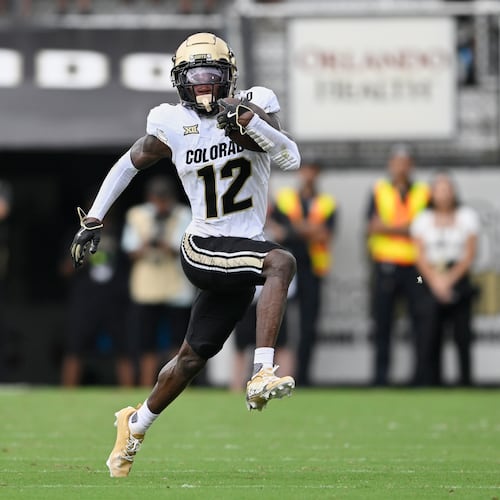Major League Baseball announced on Wednesday that, for the first time, it is recognizing the Negro Leagues, its players and statistics as part of its official history.
“All of us who love baseball have long known that the Negro Leagues produced many of our game’s best players, innovations and triumphs against a backdrop of injustice,” Commissioner Rob Manfred said. “We are now grateful to count the players of the Negro Leagues where they belong: as Major Leaguers within the official historical record.”
Manfred said MLB status has been given to seven professional Negro Leagues that operated between 1920 and 1948. The decision means the approximately 3,400 players of the Negro Leagues over that period are officially considered major leaguers, with their stats and records becoming a part of Major League history.
The seven leagues are the Negro National League (1920-31); the Eastern Colored League (1923-28); the American Negro League; the East-West League (1932); the Negro Southern League (1932); the Negro National League (1933-48); and the Negro American League (1937-48).
Those leagues combined to produce 35 Hall of Famers, and the result of MLB’s decision is that Negro League legends such as Josh Gibson, Oscar Charleston and Cool Papa Bell have achieved Major League status.
The Atlanta Black Crackers were part of the Negro Southern League and played in the 1938 Negro American League, winning the season’s second-half pennant. They played in the Negro League World Series against the Memphis Red Sox, but scheduling problems and umpire controversies caused the series to be canceled. Legendary Black Cracker first baseman James “Red” Moore was part of that 1938 team.
Baseball author and historian James A. Riley, who penned 1994′s “The Biographical Encyclopedia of the Negro Baseball Leagues,” has said that, if the Black Crackers had eventually won that series, they would have become Atlanta’s first major league sports champion, instead of the 1995 Atlanta Braves.
Moore, an Atlanta native and Booker T. Washington graduate, hit .434 in games for which box scores have been found. He also played for the Newark Eagles, the Indianapolis ABC’s and the Baltimore Elite Giants. He was a teammate of Baseball Hall of Fame members Roy Campanella, Mule Suttles, Willie Wells, Ray Dandridge and Leon Day.
Moore gained long overdue notoriety later in his life as the oldest-surviving outstanding Georgia player from the Negro Leagues. He was honored by the Atlanta Braves in 1998 on the 60th anniversary of the Atlanta Black Crackers’ second-half pennant. He was inducted into the Atlanta Sports Hall of Fame in 2006. He remains the only former Negro Leagues player bestowed that honor. Moore died in 2016, at age 99.
Jackie Robinson, who was born in Cairo, Georgia, broke MLB’s color barrier in 1947, when Brooklyn Dodgers President and General Manager Branch Rickey signed him to a Major League contract. Robinson was signed to play in the Dodgers’ farm system in 1945 and debuted for the Dodgers on April 15, 1947, a date now annually celebrated by MLB as Jackie Robinson Day.
As part of the decision, MLB and the Elias Sports Bureau — MLB’s official statistician — have begun a review process to determine the full scope of the designation’s effect on records and statistics. Historians and other experts will be consulted as part of that process.
The Negro Leagues’ status change was applauded by Negro Leagues Baseball Museum president Bob Kendrick.
“For historical merit, it is extraordinarily important,” Kendrick said. “Having been around so many of the Negro League players, they never looked to Major League Baseball to validate them. But for fans and for historical sake, this is significant, it really is. So we are extremely pleased with this announcement. And, for us, it does give additional credence to how significant the Negro Leagues were, both on and off the field.”
In 1968, MLB’s Special Committee on Baseball Records was convened by then-Commissioner William Eckert to determine which past professional leagues should be classified alongside the American League and National League as major leagues in the first publication of “The Baseball Encyclopedia.” The committee ultimately concluded that the American Association (1882-91), Union Association (1884), Players’ League (1890) and Federal League (1914-15) qualified.
At that time, the Negro Leagues were not even considered for inclusion, according to John Thorn, MLB’s official historian.
“There was no public outcry,” Thorn said. “I am reminded of Ralph Ellison’s title for the wonderful book ‘Invisible Man.’ The problem was not even perceived to exist. It’s not as if there was someone in the room raising the question and having it turned down for reasons historical or technical. It simply did not come up.”
Native Georgian Josh Gibson’s Negro Leagues-leading 238 home runs, as confirmed by Seamheads, could now be folded into MLB’s all-time leaderboard.
Less clear, however, is how rate statistics such as batting average or slugging percentage will be classified. For instance, Gibson (.365), Jud Wilson (.359), and Turkey Stearnes (.348) all had at least 3,000 career plate appearances and batting averages that would rank in the top 10 all time, according to the Seamheads database. Their inclusion on that particular list would push Ted Williams (.344) and Babe Ruth (.342) out of the top 10.
Thorn counters that the Negro Leagues were put in such a position by segregation itself.
“Peculiarities of their schedule were the outcome of prejudice,” Thorn said. “When we view the white Major Leagues of 1920-1948, it’s a binary construct — the American League and National League. That doesn’t work. A better model for understanding the Negro Leagues would be to look at the collegiate football model, where you had conference champions — the Big 10, Pac-10, SEC, ACC and so on — and then you had independents like Notre Dame and Army and Navy, who played against those conferences and then also had cupcakes on the schedule.”
MLB’s decision is the culmination of a centennial celebration of the founding of the Negro Leagues. In February, MLB and the MLB Players’ Association made a joint donation of $1 million to the Negro Leagues Baseball Museum in Kansas City to educate and raise awareness of the impact of the Negro Leagues and its players on the sport and society.
On Aug. 16, all MLB players, managers, coaches and umpires wore a symbolic Negro Leagues 100th anniversary logo patch.
About the Author
Keep Reading
The Latest
Featured


